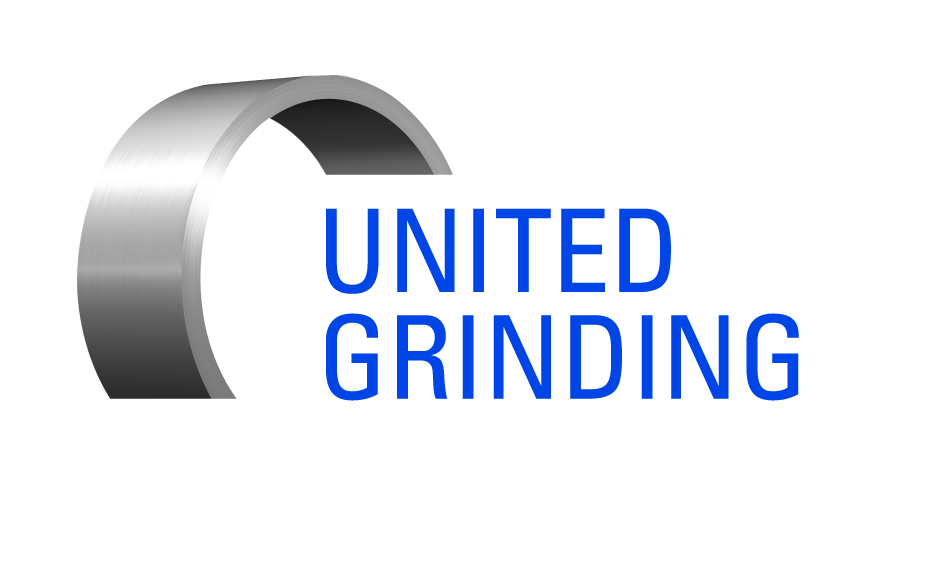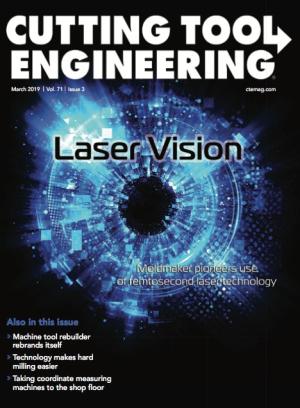What’s in a name? For KRC Machine Tool Solutions, a lot.
The Independence, Kentucky-based company launched 30 years ago as Kentucky Rebuild Corp. and focused on retrofitting, rebuilding and remanufacturing machine tools. The company later became KRC Machine Tool Services.
“We wanted to get away from the idea that we could only service the state of Kentucky,” said KRC Machine Tool Solutions Marketing Manager Caitlin DeVore, adding that KRC has a presence in almost every state and has done work internationally. “We have a new division of our business in California that we call Complete Maintenance Solutions. We have about 25 employees out there that do all the maintenance and repair work for an aerospace manufacturing facility.”
But KRC doesn’t just offer services for machine tools already producing parts and therefore rebranded itself in 2019. “The new direction is now machine tool solutions,” DeVore said. “That way, people understand we can encompass everything from service and repair at a customer facility all the way to building a new machine.”
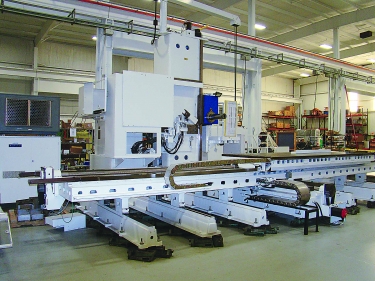
A machine remanufacture in progress at KRC Machine Tool Solutions. Image courtesy of A. Richter
In addition to building custom, multiple-axis machine tools and the new Fusion VI large-format gantry machine, which has a milling mast and secondary mast for abrasive waterjet trimming of composites, KRC recently launched a private-label line of vertical turning lathes and supplies Lazzati boring machines, Mario Carnaghi milling machines and Velocity vertical turning centers. KRC also is an authorized distributor of products for Heidenhain, Aries, Renishaw, FANUC, Siemens and Fagor.
The company remanufactures machines too and offers them as KRC-certified used machines. “From time to time in the marketplace, we will find a good machine that still has life left,” DeVore said. “We will buy it, retrofit it, do the mechanical rebuild and then sell it as a certified used machine with a new machine warranty on it. We label it as a certified used machine because we know that just like with our rebuilt machines, this machine is going to have the alignments and accuracy of OEM specifications or better. We typically do one or two of these per year, and we have four or five in storage.
The Three R’s
Basically, three options exist for getting a used machine into like-new or better condition: retrofit, rebuild or remanufacture. KRC states that a retrofit is for a mechanically sound machine with an outdated control and involves replacing the control, servo and spindle motors, drives and electrical components, along with installing new wiring. A rebuild involves reconstructing all mechanical components, replacing all bearings and seals, grinding hardened ways, hand scraping wear surfaces or replacing linear guides, repairing or replacing ballscrews, rebuilding the hydraulic and lube system, repairing or replacing way wipers and way covers, painting the machine and returning machine geometric alignments and positioning accuracy to OEM specs or better.
“It’s usually better,” said Jerry Mullins, a scraping contractor who has worked at KRC for 18 years. Mullins added that he received training from someone at the former Cincinnati Milacron Inc. about seven years prior to scraping for KRC. “He said I would probably never use this because scraping is a dying art and nobody does it. I do more scraping now than I ever have.”
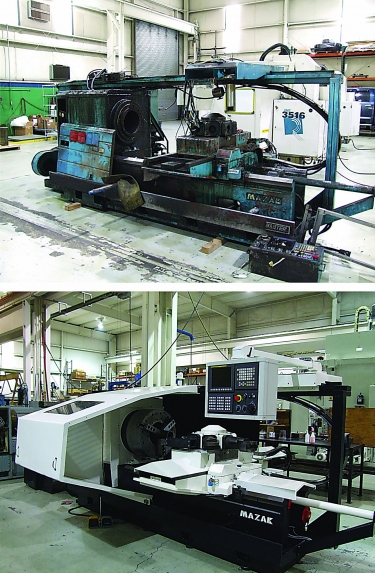
Before-and-after photos of a remanufactured Mazak Power Master turning center. Image courtesy of KRC Machine Tool Solutions
When rebuilding a circa 1976 vertical turning lathe, hand scraping consumed about eight hours a day, 40 hours a week for three or four weeks, Mullins said. “Some machines are bigger and take longer to scrape, and smaller machines you can do in a couple of weeks. With proper preventive maintenance, a good scrape job will probably last 10 years.”
A remanufacture includes all the rebuild steps, a CNC retrofit and at times a machine redesign to enhance its capabilities and improve its productivity. According to KRC, remanufacturing a machine costs about half of a new machine and is most appropriate when replacement costs exceed $600,000.
Remanufacturing or rebuilding a machine also can save time because the lead time on a new machine is usually longer. “Typically, it’s half the time to get them the machine and half the cost when rebuilding,” DeVore said.
She added that depending on the machine condition and work scope, a retrofit can take six to eight weeks, a rebuild takes roughly three to four months depending on part availability and delivery, and a remanufacture is typically at least a six-month project. Additional time might be required if replacements for worn components are no longer available and must be re-engineered and produced.
KRC annually performs five or six retrofits, about five complete in-house rebuilds at its 35,000-sq.-ft. facility and six or seven partial rebuilds at customer facilities, DeVore said. “We can never do a complete rebuild at a customer facility. There are just too many parts and not enough room, or you can’t keep the manpower out of service that long.”
The company also remanufactures or customizes two or three machines each year. “Some customers come to us with a special application or a part that they can’t quite fit on the setup of an existing piece of equipment,” DeVore said. “We have a full engineering department here that can redesign their existing machine and expand its functionality, or we can redesign and build a brand-new machine for that special application as a one-off custom machine.”
Managing a Project
DeVore emphasized that project management and the strategic planning that goes into project management provide significant value to KRC customers. “At the beginning of a project, the customer is given a detailed, mapped-out, specific line-by-line plan of how that project gets laid out. We do everything we can to hit the delivery date that we give them.”
That effort might require making strategic adjustments in labor allocation, for example, if KRC finds that it is running behind or ahead of schedule, she added. “Our customers have a commitment to their customers to deliver parts. So we have to execute on our end and make sure the delivery date that we tell them is exactly what it is. If this machine is late, that is going to cost our customer money.”
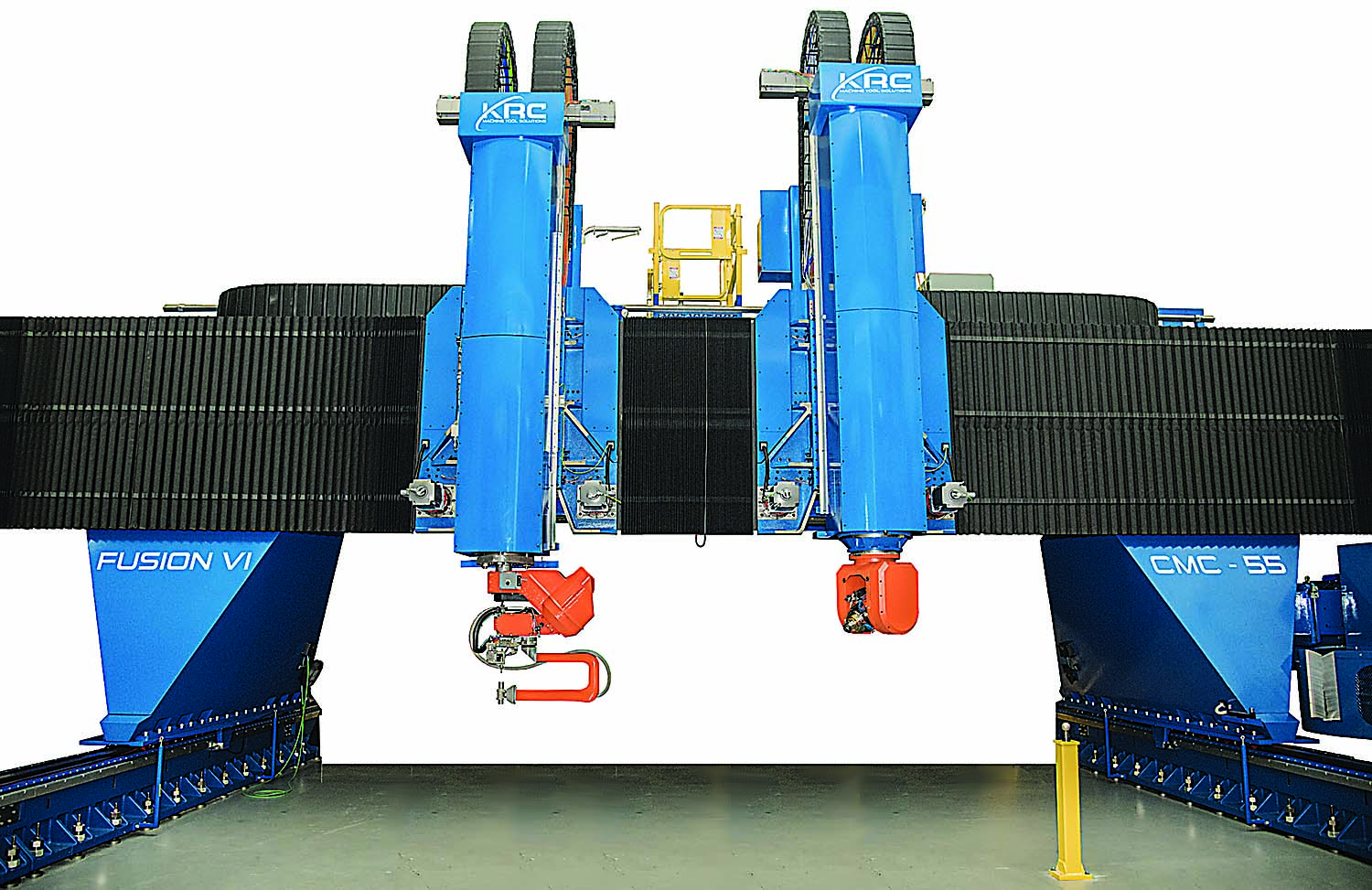
The Fusion VI gantry-style machine tool has two machining heads that move in either five axes for milling or six axes for abrasive waterjet cutting. Image courtesy of KRC Machine Tool Solutions
DeVore said KRC’s project plan covers milestones, part ordering and the installation and engineering functions. “It breaks down exactly what’s going on and how many days it’s going to take. Every single week, it is updated and sent to our customer.”
Whether it is a time-sensitive project or whether the work is performed in-house or at a customer’s facility, finding workers with the required skills can be even more challenging than in other manufacturing sectors.
“The guys that we bring in have to know a wide variety of machine tools,” DeVore said. “Our value is that when we take a service call and someone goes to a facility, he can service and troubleshoot almost every piece of equipment in that facility.”
To assist that effort, KRC is reaching out to trade schools to develop partnerships and relationships with them and help them create curricula for providing the proper training, she added. In return, KRC would help with their training and possibly provide employment. “That way, we are bringing in young talent while we have so many seasoned people here who are just full of knowledge that they can share. A lot of guys have worked here for 10, 15, 20 years.”
Next Generation
To help continue its growth trajectory, KRC launched the Fusion VI series of multiple-process gantry-style machine tools with a movable bridge and dual vertical masts on parallel rails suspended above the work area. Last year, KRC entered into a technology agreement with Flow Aerospace Systems LLC, Jeffersonville, Indiana, and its partner, Ascent Aerospace LLC, Macomb, Michigan, for the rights to the design and manufacture of its Gen 5 gantry composite machining centers.
DeVore explained, however, that Flow Aerospace has since “shut their doors, and we were able to work with some of their former employees and bring them on board.” Those employees included the chief engineer and project manager.
With that expertise and KRC’s designing, building and retrofitting experience, KRC introduced the sixth-generation Fusion VI machine, which can perform trimming, drilling, routing, milling, marking and inspection in one setup. The two machining heads move in either five axes for milling or six axes for abrasive waterjetting, powered by Flow ultrahigh-pressure intensifiers and cutting heads, along the defined toolpath to produce a completed part. This configuration is tailored for processing composite aerostructures, as well as large parts made of various materials, according to the company.
“Composites is huge in aerospace but is also getting bigger in automotive,” DeVore said. “As we continue to grow, we will find ourselves filtering into different industries and markets based on where the demand is.”
For more information about KRC Machine Tool Solutions, call 859-283-8300 or visit www.krcmachinetoolsolutions.com.
Rebuilding Capacity and Efficiency
It’s no secret that grinding machines age through wear and tear. After decades of heavy use, especially with deferred routine maintenance, grinders’ accuracy and geometry begin to suffer as the machines essentially grind themselves away. When downtime becomes more frequent than production time, however, the newly expanded rebuild department at United Grinding North America Inc., Miamisburg, Ohio, has the capability to put equipment back in service, restoring it to its original specifications or even adding functionality.
United Grinding North America began performing rebuild services in 2010. In less than a decade, the company has expanded from providing basic parts and services to doing full tear-down rebuilds that replace virtually every part, yielding like-new equipment. With materials, parts, machine shops and technicians under one roof at company headquarters, the rebuild department offers enhanced capacity to bring machines back to productive life.
To maintain brand-specific capabilities and specifications for Blohm, Mägerle and Walter grinders, technicians train at factory sites in Europe. For select brands and machines, the department can even update software and controls to match and interconnect with newer products. By 2020, the department plans to add Studer to the roster of brands handled in-house.
Overhauls begin with a full tear-down, close examination of every part and replacement of all worn components. Externally, the basic casting undergoes steam cleaning followed by abrasive blasting and three fresh coats of epoxy paint. Cleaning, blasting and painting refresh the enclosure, which also receives new windows and modern brand styling. The results recertify as new, potentially doubling the life cycle.
Although these procedures require customers to ship equipment for service rather than relying on a local rebuilding service, the OEM knows the equipment that it built better than any third party. So the OEM-trained rebuild department uses only OEM parts, offers a one-year warranty for rebuilding work and supports rebuilt machines on the shop floor.
Rebuilt grinding machines cost about 75 percent of the price of new equipment. Nonetheless, a rebuilt grinder looks, works and produces like new, with recommissioned geometry, renewed guide ways and enhanced precision. A rebuilt machine can maintain familiar control procedures, reducing the need to retrain operators on new equipment. Furthermore, depending on how a company classifies expenses, a rebuilt machine may qualify as a maintenance cost rather than as a capital outlay.
Retrofitting adds innovations that manufacturers introduced after older models went into service. Examples of such technologies are LED lighting, glass scale motion encoders, updated controls and the ability to tackle new forms of production. Advantages of these retrofits include up-to-date developments in the human-machine interfaces, which replace code entry procedures with intuitive Q&A sequences that can eliminate confusion and open up machine operations to a broader range of personnel. The on-site service that adds these options minimizes downtime.
The rebuild department also can add capabilities to an existing machine. To accommodate high-pressure coolant and advanced grinding wheels, for example, an enclosure may be designed for an open-configuration machine. Repurposing can add robotic automation and rotary dressing to machines.
—Harold Tuttle, senior field service manager, United Grinding North America Inc.
Contact Details
Related Glossary Terms
- abrasive
abrasive
Substance used for grinding, honing, lapping, superfinishing and polishing. Examples include garnet, emery, corundum, silicon carbide, cubic boron nitride and diamond in various grit sizes.
- abrasive waterjet ( AWJ)
abrasive waterjet ( AWJ)
System that uses high-pressure waterjets in combination with a slurry of fine abrasive grains to machine materials. See waterjet cutting.
- boring
boring
Enlarging a hole that already has been drilled or cored. Generally, it is an operation of truing the previously drilled hole with a single-point, lathe-type tool. Boring is essentially internal turning, in that usually a single-point cutting tool forms the internal shape. Some tools are available with two cutting edges to balance cutting forces.
- centers
centers
Cone-shaped pins that support a workpiece by one or two ends during machining. The centers fit into holes drilled in the workpiece ends. Centers that turn with the workpiece are called “live” centers; those that do not are called “dead” centers.
- composites
composites
Materials composed of different elements, with one element normally embedded in another, held together by a compatible binder.
- computer numerical control ( CNC)
computer numerical control ( CNC)
Microprocessor-based controller dedicated to a machine tool that permits the creation or modification of parts. Programmed numerical control activates the machine’s servos and spindle drives and controls the various machining operations. See DNC, direct numerical control; NC, numerical control.
- coolant
coolant
Fluid that reduces temperature buildup at the tool/workpiece interface during machining. Normally takes the form of a liquid such as soluble or chemical mixtures (semisynthetic, synthetic) but can be pressurized air or other gas. Because of water’s ability to absorb great quantities of heat, it is widely used as a coolant and vehicle for various cutting compounds, with the water-to-compound ratio varying with the machining task. See cutting fluid; semisynthetic cutting fluid; soluble-oil cutting fluid; synthetic cutting fluid.
- dressing
dressing
Removal of undesirable materials from “loaded” grinding wheels using a single- or multi-point diamond or other tool. The process also exposes unused, sharp abrasive points. See loading; truing.
- gang cutting ( milling)
gang cutting ( milling)
Machining with several cutters mounted on a single arbor, generally for simultaneous cutting.
- grinding
grinding
Machining operation in which material is removed from the workpiece by a powered abrasive wheel, stone, belt, paste, sheet, compound, slurry, etc. Takes various forms: surface grinding (creates flat and/or squared surfaces); cylindrical grinding (for external cylindrical and tapered shapes, fillets, undercuts, etc.); centerless grinding; chamfering; thread and form grinding; tool and cutter grinding; offhand grinding; lapping and polishing (grinding with extremely fine grits to create ultrasmooth surfaces); honing; and disc grinding.
- lathe
lathe
Turning machine capable of sawing, milling, grinding, gear-cutting, drilling, reaming, boring, threading, facing, chamfering, grooving, knurling, spinning, parting, necking, taper-cutting, and cam- and eccentric-cutting, as well as step- and straight-turning. Comes in a variety of forms, ranging from manual to semiautomatic to fully automatic, with major types being engine lathes, turning and contouring lathes, turret lathes and numerical-control lathes. The engine lathe consists of a headstock and spindle, tailstock, bed, carriage (complete with apron) and cross slides. Features include gear- (speed) and feed-selector levers, toolpost, compound rest, lead screw and reversing lead screw, threading dial and rapid-traverse lever. Special lathe types include through-the-spindle, camshaft and crankshaft, brake drum and rotor, spinning and gun-barrel machines. Toolroom and bench lathes are used for precision work; the former for tool-and-die work and similar tasks, the latter for small workpieces (instruments, watches), normally without a power feed. Models are typically designated according to their “swing,” or the largest-diameter workpiece that can be rotated; bed length, or the distance between centers; and horsepower generated. See turning machine.
- milling
milling
Machining operation in which metal or other material is removed by applying power to a rotating cutter. In vertical milling, the cutting tool is mounted vertically on the spindle. In horizontal milling, the cutting tool is mounted horizontally, either directly on the spindle or on an arbor. Horizontal milling is further broken down into conventional milling, where the cutter rotates opposite the direction of feed, or “up” into the workpiece; and climb milling, where the cutter rotates in the direction of feed, or “down” into the workpiece. Milling operations include plane or surface milling, endmilling, facemilling, angle milling, form milling and profiling.
- parallel
parallel
Strip or block of precision-ground stock used to elevate a workpiece, while keeping it parallel to the worktable, to prevent cutter/table contact.
- toolpath( cutter path)
toolpath( cutter path)
2-D or 3-D path generated by program code or a CAM system and followed by tool when machining a part.
- turning
turning
Workpiece is held in a chuck, mounted on a face plate or secured between centers and rotated while a cutting tool, normally a single-point tool, is fed into it along its periphery or across its end or face. Takes the form of straight turning (cutting along the periphery of the workpiece); taper turning (creating a taper); step turning (turning different-size diameters on the same work); chamfering (beveling an edge or shoulder); facing (cutting on an end); turning threads (usually external but can be internal); roughing (high-volume metal removal); and finishing (final light cuts). Performed on lathes, turning centers, chucking machines, automatic screw machines and similar machines.
- waterjet cutting
waterjet cutting
Fine, high-pressure (up to 50,000 psi or greater), high-velocity jet of water directed by a small nozzle to cut material. Velocity of the stream can exceed twice the speed of sound. Nozzle opening ranges from between 0.004" to 0.016" (0.l0mm to 0.41mm), producing a very narrow kerf. See AWJ, abrasive waterjet.

